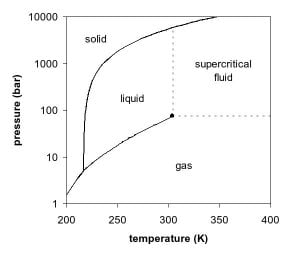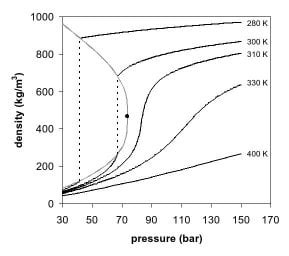Difference between revisions of "Supercritical fluid" - New World Encyclopedia
(imported latest version of article from Wikipedia) |
(added credit and category tags, deleted foreign language links) |
||
| Line 61: | Line 61: | ||
* [http://www.foodproductdesign.com/archive/1997/0597NT.html Food Product Design] | * [http://www.foodproductdesign.com/archive/1997/0597NT.html Food Product Design] | ||
| + | [[Category:Physical sciences]] | ||
| + | [[Category:Physics]] | ||
| + | [[Category:Chemistry]] | ||
| + | [[Category:Materials science]] | ||
| + | [[Category:Technology]] | ||
[[Category:Condensed matter physics]] | [[Category:Condensed matter physics]] | ||
| − | + | {{credit|78058739}} | |
| − | |||
| − | |||
Revision as of 16:36, 1 December 2006
A supercritical fluid is any substance at a temperature and pressure above its thermodynamic critical point. It has the unique ability to diffuse through solids like a gas, and dissolve materials like a liquid. Additionally, it can readily change in density upon minor changes in temperature or pressure. These properties make it suitable as a substitute for organic solvents in a process called Supercritical Fluid Extraction. Carbon dioxide and water are the most commonly used supercritical fluids.
Introduction
In 1822, Baron Charles Cagniard de la Tour discovered the critical point of a substance in his famous cannon barrel experiments. Listening to discontinuities in the sound of a rolling flint ball in a sealed cannon filled with fluids at various temperatures, he observed the critical temperature. Above this temperature, the densities of the liquid and gas phases become equal and the distinction between them disappears, resulting in a single supercritical fluid phase. In Table 1, the critical properties are shown for some components, which are commonly used as supercritical fluids.
Phase diagram
The observations by de la Tour can be explained by looking at the phase diagram of a pure component, e.g. carbon dioxide. In Figures 1 and 2, two projections of the phase diagram of carbon dioxide are shown. In the pressure-temperature phase diagram (Fig. 1) the boiling line is observed, which separates the vapor and liquid region and ends in the critical point. At the critical point, the densities of the equilibrium liquid phase and the saturated vapor phases become equal, resulting in the formation of a single supercritical phase. This can be observed in the density-pressure phase diagram for carbon dioxide, as shown in Figure 2, where the critical point is located at 304.1 K and 7.38 MPa (73.8 bar). With increasing temperatures, the liquid-vapor density gap decreases, up to the critical temperature, at which the discontinuity disappears. Thus, above the critical temperature a gas cannot be liquefied by pressure. However, at extremely high pressures the fluid can solidify, as visible at the top of Figure 1. By definition, a supercritical fluid is a substance above both its critical temperature and pressure. In a practical sense, the area of interest in supercritical fluids for processing and separation purposes is limited to temperatures in the vicinity of the critical point, where large gradients in the physical properties are observed. The changes near the critical point are not limited to density. Many other physical properties also show large gradients with pressure near the critical point, e.g. viscosity, the relative permittivity and the solvent strength, which are all closely related to the density. At higher temperatures, the fluid starts to behave like a gas, as can be seen in Figure 2. For carbon dioxide at 400 K, the density increases almost linearly with pressure.
Applications
For engineering purposes, supercritical fluids can be regarded as “hybrid solvents” with properties between those of gases and liquids, i.e. a solvent with a low viscosity, high diffusion rates and no surface tension. In the case of supercritical carbon dioxide, the viscosity is in the range of 20–100 µPa·s (0.02-0.1 cP), where liquids have viscosities of approximately 500–1000 µPa·s (0.5-1.0 cP) and gases approximately 10 µPa·s (0.01 cP), respectively. Diffusivities of solutes in supercritical carbon dioxide are up to a factor 10 higher than in liquid solvents. Additionally, these properties are strongly pressure-dependent in the vicinity of the critical point, making supercritical fluids highly tunable solvents. Of the components shown in Table 1, carbon dioxide and water are the most frequently used in a wide range of applications, including extractions, dry cleaning and chemical waste disposal. In polymer systems, ethylene and propylene are also widely used, where they act both as a solvent and as the reacting monomer.
| Solvent | Molecular Weight | Temperature | Pressure | Density | |
|---|---|---|---|---|---|
| Units | (g/mol) | (K) | (MPa) | (bar) | (g/cm³) |
| Carbon dioxide | 44.01 | 304.1 | 7.38 | 73.8 | 0.469 |
| Water | 18.02 | 647.3 (647.096)² | 22.12 (22.064)² | 221.2 (220.64)² | 0.348 |
| Methane | 16.04 | 190.4 | 4.60 | 46.0 | 0.162 |
| Ethane | 30.07 | 305.3 | 4.87 | 48.7 | 0.203 |
| Propane | 44.09 | 369.8 | 4.25 | 42.5 | 0.217 |
| Ethylene | 28.05 | 282.4 | 5.04 | 50.4 | 0.215 |
| Propylene | 42.08 | 364.9 | 4.60 | 46.0 | 0.232 |
| Methanol | 32.04 | 512.6 | 8.09 | 80.9 | 0.272 |
| Ethanol | 46.07 | 513.9 | 6.14 | 61.4 | 0.276 |
| Acetone | 58.08 | 508.1 | 4.70 | 47.0 | 0.278 |
² "Properties of Water and Steam", W. Wagner & A. Kruse.
See also
- Supercritical carbon dioxide
ReferencesISBN links support NWE through referral fees
- R.C. Reid, J.M. Prausnitz and B.E. Poling, The properties of gases and liquids, 4th ed., McGraw-Hill, New York, 1987.
- W. Wagner and A. Kruse, Properties of Water and Steam, Springer-Verlag, Berlin, 1998.
Further reading
Credits
New World Encyclopedia writers and editors rewrote and completed the Wikipedia article in accordance with New World Encyclopedia standards. This article abides by terms of the Creative Commons CC-by-sa 3.0 License (CC-by-sa), which may be used and disseminated with proper attribution. Credit is due under the terms of this license that can reference both the New World Encyclopedia contributors and the selfless volunteer contributors of the Wikimedia Foundation. To cite this article click here for a list of acceptable citing formats.The history of earlier contributions by wikipedians is accessible to researchers here:
The history of this article since it was imported to New World Encyclopedia:
Note: Some restrictions may apply to use of individual images which are separately licensed.

